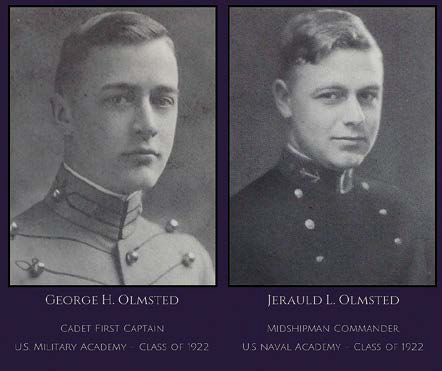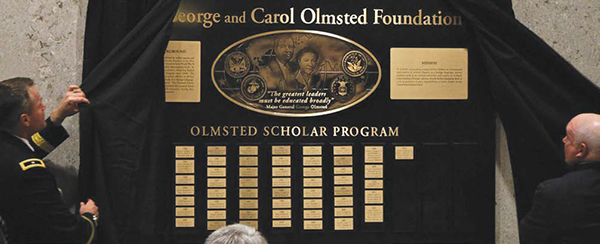In the days leading up to the contest, practicing under wretched weather conditions at West Point with a steady fall of sleet and hail, the Army football team prepared for the 24th Army-Navy game set to take place at the Polo Grounds in New York City on November 26, 1921.
On that day, the rain and chill did not dampen the enthusiasm of the capacity crowd of 45,000, including those among the eager public fortunate enough to obtain a ticket. Despite the weather it was a notable gathering, among the most notable that had ever seen an Army-Navy game.
Although a cold prevented Chief of Staff of the Army GEN Pershing 1886 from attending the game, in attendance were Vice President and Mrs. Coolidge; Secretary of War John W. Weeks; USMA Superintendent GEN Douglas MacArthur 1903 and Secretary of the Navy Edwin Denby; and down through official ranks encompassing governors, senators, congressmen, and New York City’s mayor. The New York Times reported a long list of notable military, business, and civic leaders; representatives of the British, French, Italian, and Japanese armies; and prominent members of society from New York and all the large Eastern cities “on hand in furs.”
With 11 wins each in the previous 30 years, this game was the chance for each academy to break the tie. After a close and exciting struggle in the mud and rain, the Army team was beaten, but not disgraced, holding Navy to a final score of 7-0. This win was Navy’s third-straight victory over Army and its last until 1934.

This game was historic for another reason. Leading the Corps of Cadets and Midshipmen onto the field that day were two brothers: George H. Olmsted and Jerauld L. Olmsted. This represented a singular event in the history of both West Point and Annapolis, when two brothers served simultaneously as the leaders at their respective academies. In the academic year of 1921–1922, George was the First Captain and regimental commander and graduated second in his class at the U.S. Military Academy, while Jerauld served as the first detail regimental commander of Midshipmen at the U.S. Naval Academy.
2022 marked the centennial of the graduation of the Olmsted brothers—the grandsons of MAJ Jerauld A. Olmsted, USMA Class of 1870—and for the past 100 years, this family legacy of service and leadership has had a lasting impact at both academies while promoting excellence and scholarship in generations of America’s military leaders. This legacy is carried out through the work of the George and Carol Olmsted Foundation, and central to this vision is George Olmsted’s “conviction that the greatest leaders must be educated broadly.”
Ensign Jerauld Olmsted went on to serve on the battleship Wyoming, but sadly died of polio in 1923 at the age of 23.
George Olmsted resigned his commission as a Lieutenant in 1923, and returned to his native Iowa to open an insurance agency with his father. Just six years later, he purchased the first of 11 insurance companies. Ultimately, Olmsted became president and chairman of the multi-faceted International Bank of Washington, DC, whose activities spanned the globe in the fields of international banking, insurance, and financing and leasing operations.
Olmsted was called to active duty in 1941 and served in the Pentagon until he was named assistant to the China Theatre Commander, GEN Douglas MacArthur 1903. He is credited with the release and rescue of 35,000 soldiers and civilians from Japanese prison camps in 1945, and was awarded the Distinguished Service Medal that year. He earned the Legion of Merit and Bronze Star, as well as medals from Britain, France, and China. During the Korean War, Olmsted served as Director of Military Assistance and he retired in 1953 as a Major General. He then served as Commanding General of the 103rd Infantry Division of the Army Reserve until 1959. He died in 1998 at the age of 97.
Based on his experience in post-war China, Olmsted felt strongly that young military leaders should be educated broadly, cultivating an understanding of a foreign culture that would contribute to stronger leadership. Thus, two programs are at the core of the Olmsted Foundation’s work to educate our military leaders: the Olmsted Scholar Program and the Undergraduate Overseas Travel and Cultural Immersion Program.
The Olmsted Scholar Program, established with an initial grant from George and Carol Olmsted in 1957, awards scholarships to highly qualified, active duty junior officers for language studies and graduate-level education. Created in concert with the Department of Defense, the program provides one year of foreign language training followed by two years of study at a foreign graduate school. Olmsted Scholars have studied at over 200 universities in more than 60 countries and 40 languages.
The inaugural class of 1960 included three West Point graduates, COL William E. Albright Jr. USAF, Retired 1954; COL Richard W. Hobbs USA, Retired 1954; and LTG Frederic J. Brown USA, Retired 1956. A plaque commemorating all USMA Olmsted Scholars is maintained in the Robinson Auditorium lobby in Thayer Hall. Since its inception, the program has provided grants for over 700 officers, many of whom have gone on to the highest levels of leadership and responsibility in the military, government, and private sector.
Olmsted’s commitment to education goes beyond young military officers. Complementing the Olmsted Scholars Program is the Foundation’s undergraduate program, which supports overseas travel and cultural immersion opportunities for students at USMA; the Naval, Air Force, and Coast Guard academies; and other private and public military academies and universities.
At West Point, the George and Carol Olmsted Foundation Cultural Immersion Program was established in 2001, and since then has provided over 850 cadets with the broadening experiences that are critical for effective leader development. The program currently supports approximately 20 West Point cadets each year with overseas study and immersion trips that enable them to gain language proficiency, cultural awareness, and regional expertise.
Beyond these signature programs, the Olmsted legacy has had further impact at West Point.
Since 2002, the Olmsted Foundation has also contributed to undergraduate professional and leadership development through its support of the Student Conference on U.S. Affairs (SCUSA). SCUSA is a four-day conference in which students work with scholars and practitioners to develop policy proposals that address important topics in U.S. foreign policy. SCUSA is one of the largest conferences of its type and is attended by approximately 200 undergraduate students from over 125 colleges and universities worldwide.
With the goal of educating young people about the history of West Point and the challenges and rewards offered by a military career, in 1979 the Olmsted Foundation made a significant gift to help fund the relocation of the West Point Museum from Thayer Hall to its current home at Pershing Center. To recognize this support, the new museum facility was re-named Olmsted Hall. Olmsted’s gift also contributed to the establishment of a dedicated endowment to support the museum, which over the years has provided funds for the acquisition of museum artifacts, documents, and artwork; maintenance, repair, and improvements; special exhibits and displays; and educational programs.
In addition, the history of fundraising support for West Point and the Margin of Excellence can be traced to Olmsted. An active fundraising program was nonexistent at West Point until 1961, when a group of graduates, headed by Association of Graduates Chairman GEN Lucius D. Clay 1918 and Vice Chairman Olmsted established the West Point Superintendent’s Fund. This vision set the foundation for the exponential growth and success of fundraising efforts to secure and expand the Margin of Excellence and be a continued part of West Point’s development and future.
As we look to the next 100 years, George Olmsted’s vision, his generosity, and his example of service and leadership will continue to cultivate and transform leaders who aspire to positions of great responsibility and public service. From his years as leader of the Corps of Cadets until today, George Olmsted has helped to shape leaders who understand the world and who will serve our country with distinction and character.




